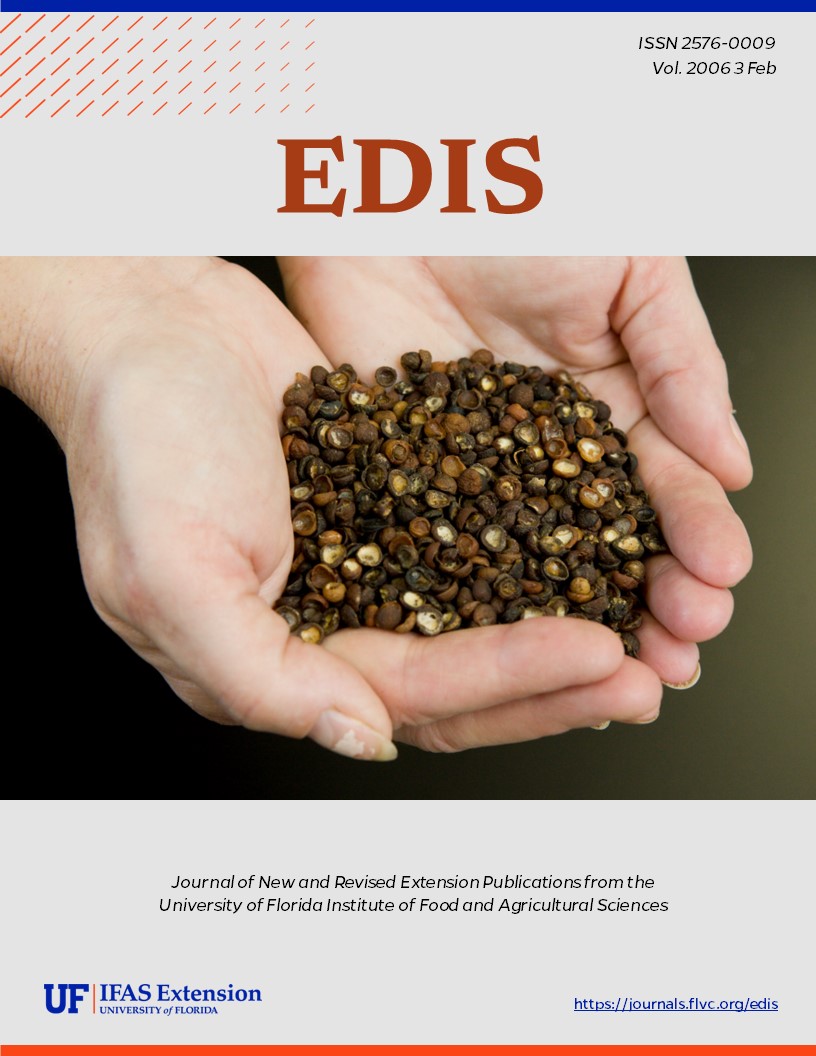Abstract
The bella moth, Utetheisa ornatrix (Linnaeus), is one of our most beautiful moths. Unlike most moths, which are nocturnal, the bella moth is diurnal and flies readily when disturbed. Therefore, it is more commonly seen than nocturnal species by the general public. This document is EENY-358 (IN644), one of a series of Featured Creatures from the Entomology and Nematology Department, UF/IFAS Extension. Original publication date October 2005.
References
Common Names of Insects and Related Organisms. (1995-2005). Entomological Society of America. http://www.entsoc.org/Pubs/Books/Common_Names/results.asp (28 September 2005).
Connor WE, Roach B, Benedict E, Meinwald J, Eisner T. 1990. Courtship pheromone production and body size as correlates of larval diets in males of the arctiid moth, Utetheisa ornatrix. Journal of Chemical Ecology 16:543:552. https://doi.org/10.1007/BF01021785
Connor WE, Eisner T, Vander Meer RK, Guerrero A, Meinwald J. 1981. Precopulatory sexual interaction in an arctiid moth (Utetheisa ornatrix): role of a pheromone derived from dietary alkaloids. Behavioral Ecology and Sociobiology 9:227-235. https://doi.org/10.1007/BF00302942
Connor WE, Boada R, Schroeder FC, González A, Meinwald J, Eisner T. 2000. Chemical defence: bestowal of a nuptial alkaloidal garment by a male moth upon its mate. Proceedings of the National Academy of Sciences USA 97:14406-14411. https://doi.org/10.1073/pnas.260503797
Connor WE, Eisner T, Vander Meer RK, Guerrero A, Ghiringelli D, Meinwald J. 1980. Sex attractant of an arctiid moth (Utetheisa ornatrix): a pulsed chemical signal. Behavioral Ecology and Sociobiology 7:55-63. https://doi.org/10.1007/BF00302519
Covell CV. 1984. A Field Guide to the Moths of Eastern North America. Houghton Mifflin Company. Boston.
Doussard DE, Harvis CA, Meinwald J, Eisner T. 1991. Pheromonal advertisement of a nuptial gift by a male moth Utetheisa ornatrix. Proceedings of the National Academy of Sciences USA 88:9224-9227. https://doi.org/10.1073/pnas.88.20.9224
Doussard DE, Ubik K, Harvis CA, Resch J, Meinwald J, Eisner T. 1988. Biparental defensive endowment of eggs with acquired plant alkaloid in the moth Utetheisa ornatrix. Proceedings of the National Academy of Sciences USA 85:5992-5996. https://doi.org/10.1073/pnas.85.16.5992
Eisner T. 2003. For Love of Insects. Harvard University Press. Cambridge, Massachusetts.
Eisner T, Eisner M. 1991. Unpalatability of the pyrrolizidine alkaloid containing moth, Utetheisa ornatrix, and its larva, to wolf spiders. Psyche 98:111-118. https://doi.org/10.1155/1991/95350
El-Sayed AM (2004). Compound - Z3Z6Z9-21Hy. The Pherobase: Database of Insect Pheromones and Semiochemicals. http://www.pherobase.com/database/compounds-detail-Z3Z6Z9-21Hy.html (28 September 2005).
Forbes WTM. 1960. The Lepidoptera of New York and neighboring states. Part IV. Agaristidae through Nymphalidae, including butterflies. Cornell University Agricultural Experiment Station Memoir 329. Ithaca, New York.
González A, Rossini C, Eisner M, Eisner T. 1999. Sexually transmitted chemical defense in a moth (=Utetheisa ornatrix). Proceedings of the National Academy of Sciences USA 96:5570-5574. https://doi.org/10.1073/pnas.96.10.5570
Heitzman JR, Heitzman JE. 1987. Butterflies and Moths of Missouri. Missouri Department of Conservation. Jefferson, Missouri.
Iyengar VK, Eisner T. 1999. Female choice increases offspring fitness in an arctiid moth (Utetheisa ornatrix). Proceedings of the National Academy of Sciences USA 96:15013-15016. https://doi.org/10.1073/pnas.96.26.15013
Iyengar VK, Eisner T. 1999.Heritability of body mass, a sexually selected trait in an arctiid moth (Utetheisa ornatrix). Proceedings of the National Academy of Sciences USA 96:9169-9171. https://doi.org/10.1073/pnas.96.16.9169
Iyengar VK, Rossini C, Eisner T. 2001. Precopulatory assessment of male quality in an arctiid moth (Utetheisa ornatrix): hydroxydanaidal is the only criterion of choice. Behavioral Ecology and Sociobiology 49:283-288. https://doi.org/10.1007/s002650000292
Isley D. 1990.Vascular Flora of the Southeastern United States. Vol. 3, Part 2. Leguminosae (Fabaceae). The University of North Carolina Press. Chapel Hill.
Jain SC, Doussard DE, Conner WE, Eisner T, Guerrero A, Meinwald J. 1983. Polyene pheromone components from an arctiid moth (Utetheisa ornatrix): characterization and synthesis. Journal of Organic Chemistry 48:2266-2270. https://doi.org/10.1021/jo00161a024
Kimball CP. 1965. Lepidoptera of Florida. Arthropods of Florida and Neighboring Land Areas. Division of Plant Industry. State of Florida Department of Agriculture. Gainesville, Florida.
LaMunyon CW. 1997. Increased fecundity, as a function of multiple mating, in an arctiid moth, Utetheisa ornatrix. Ecological Entomology 22:69-73. https://doi.org/10.1046/j.1365-2311.1997.00033.x
Linnei C. 1758. System Naturae. Regnum Animale. 10th Ed. Lipsiae, sumptibus Guilielmi Engelmann, 1894. (In Latin)
Opler P. (2004). Moths of North America. United States Geological Survey Northern Prairie Wildlife Research Center. http://www.npwrc.usgs.gov/resource/distr/lepid/moths/mothsusa.htm (28 September 2005).
Tietz, HM. 1972. An Index to the Described Life Histories, Early Stages and Hosts of the Macrolepidoptera of the Continental United States and Canada. Vol. 1. The Allyn Museum of Entomology. Sarasota, Florida.
Stehr FW. 1987. Immature Insects. Vol. 1. Kendall/Hunt Publishing Company. Dubuque, Iowa.
United States Department of Agriculture. (2005). Natural Resources Conservation Service Plants Database. http://plants.usda.gov/ (28 September 2005).
Wunderlin RP, Hansen BF. 2003. Guide to the Vascular Plants of Florida. University Press of Florida. Gainesville, Florida. 2nd edition.
Wunderlin RP, Hansen BF. (2005). Atlas of Florida Vascular Plants. [Landry SM, Campbell KN. (application development), Florida Center for Community Design and Research.] Institute for Systematic Botany, University of South Florida, Tampa. http://www.plantatlas.usf.edu/ (28 September 2005).

